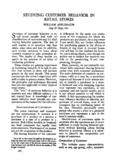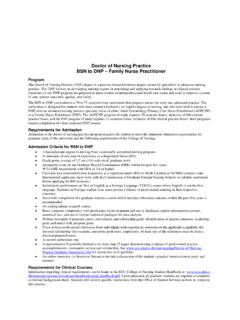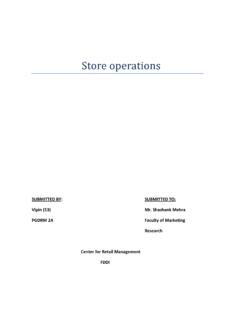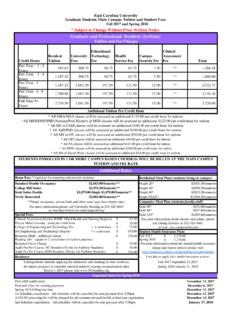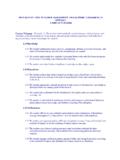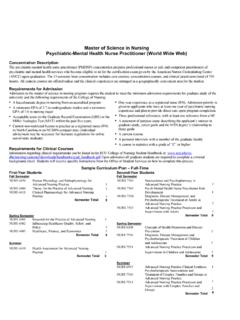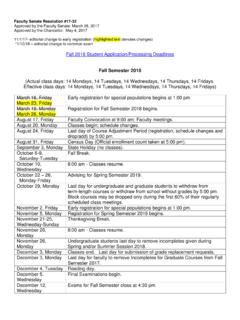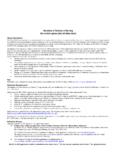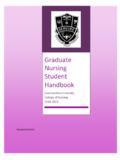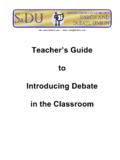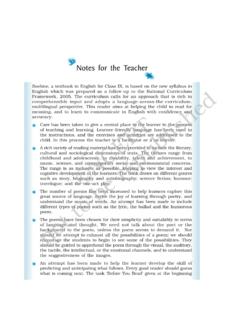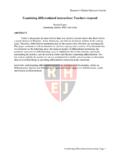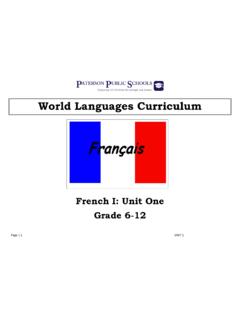Transcription of CONCEPT LEARNING: Examples & Non-Examples Compare & …
1 Procedural Knowledge LevelInstructional Strategy Lessons for Educators Secondary Education (ISLES-S) CONCEPT learning : Examples & Non-ExamplesCompare & ContrastInstructionalStrategiesA CONCEPT is defined by Lynn Erickson as "a mental construct that is timeless, universal and abstract. Concepts, such as intertextuality, ecosystems, prime numbers, and culture, are rich ideas to which facts and Examples are attached. Using Examples and non- Examples as well as comparison and contrast as students are learning new concepts helps to clarify complex ideas, to expose relationships and patterns among even dissimilar concepts, and to organize new information into meaningful all topics are concepts, however, and the two terms shouldn t be confused.
2 Neither are causes considered LearningInstructionalStrategiesExamples & Non- Examples First ImpressionsTo use Examples and non- Examples to enhance student understanding of the How can you use Examples and non- Examples in a meaningful way to guide student learning ?1. Identify how to teach concepts by using Examples and Determine when it is appropriate to use the strategy. 3. Plan a lesson that uses Examples and Examine a video that uses a Frayer Map to illustrate use of Examples and non- Examples in the 1 ExplorationExamples and non- Examples can be featured anywhere in a unit or lesson, but are most often used when introducing new concepts.
3 Using Examples helps students to generalize concepts and see relationships among similar ideas. Non- Examples , on the other hand, teach students to differentiate among ideas and concepts so that they do not :Students will be able do you implement the strategy?Step 1. Name or label the CONCEPT to be 2. Provide a definition of the CONCEPT that is specific enough to differentiate it from other 3. Identify and discuss key attributes that distinguish the CONCEPT in question from other similar 4. Give Examples that fit the definition and illustrate these essential 5.
4 Identify and discuss non- Examples so that students can see and practice 2 What's This?The Frayer model is a graphic organizer used to analyze a CONCEPT by: Name or Label Definition Examples Essential Attributes Non-Essential Attributes Non-ExamplesIn this video, the teacher uses Examples and non- Examples in conjunction with the Frayer model to teach her students about propaganda used during the Holocaust. As you watch, consider what you have learned about using Examples and non- Examples . Propaganda6 Take a Look Plan your lessonUsing a blank template of the infographic on the previous page, plan out your own lesson using Examples and : Video AnalysisAnalyze how the teacher in this video uses Examples and non- Examples to teach the lesson s CONCEPT to LinksDiscipline References of Examples and Non-examplesMath: Polynomial Examples and nonexamples History: de facto vs.
5 De jure segregation English: Examples : Paraphrasing Plagiarism: How to Recognize Plagiarism Science: Using Visual Examples to Teach Boyle's Law Business: Business communications General: Frayer Model | Classroom StrategiesSection 3 Think AboutReviewExamples and support CONCEPT mastery. develops skills needed for problem-solving. to help students transfer previously learned knowledge to new concepts. promote autonomy in CONCEPT 4 ResourcesHolocaust Unit Video: Literacy Support: Frayer Model. (2010). Retrieved from & ContrastFirst ImpressionsTo aid students in developing critical thinking skills and provide a means to organize new How can you design and use the Compare & contrast instructional strategy in a meaningful way to guide student learning ?
6 How to teach concepts by using comparison and when it is appropriate to use the strategy. a lesson that uses the Compare and contrast a site that demonstrates the classroom use of comparison and 1 ExplorationIdentifying patterns is a natural process for humans, and Compare and contrast capitalizes on this intrinsic ability in order to aid learning . The strategy can be used at any point in a lesson to help students gain a deeper understanding of the concepts being :Students will be able 2 What's This?Comparing and Contrasting being explained by the UNC Writing Center Using Compare and ContrastHow do you implement the strategy?
7 Step 1. Select concepts to Compare and 2. Determine what format students will use to Compare and contrast the concepts, , using a graphic 3. Provide students time to brainstorm similarities and differences between 4. Ask students to determine possible relationships between concepts based on 5. Check for do you use Compare and contrast effectively?The Compare and contrast technique works best when there is a close relationship between the concepts being example, you might ask students to Compare and the protagonist and antagonist of a story or two poems, movies, or plays in language arts.
8 Photosynthesis and digestion or two celestial bodies in science. two historical figures or two houses of Congress in social studies. two geometric shapes or real and rational numbers in a LookHot Links Instructional Strategies Online: Compare & Contrast More information about the Compare and contrast strategy with links to graphic organizers. Thoughtful Classroom: Compare & Contrast Sample Lessons Sample lessons from prominent author Harvey Silver. Compare and Contrast Ideas on Pinterest There are more where this came from. Pinterest is quickly becoming a storehouse for educational strategies.
9 Using Compare and contrast to teach the Common Core A collection of strategies for sixth through eighth grade classrooms with blank templates and primary resources in 3 Think AboutExamine this site where one high school teacher demonstrates how she incorporates Compare and contrast while covering the topic of essays. Notice how she introduces the topic by specifically stating the purpose of the activity. She models the technique while emphasizing the academic language used for the instructional strategy, and she includes guided practice time within the reviewing this lesson, take a moment to think about the reasons she provided for choosing Compare /contrast as an instructional strategy.
10 Consider how this approach could understanding within your content could you use the Compare and contrast strategy with this visual? format would you use with this visual ( , Venn diagram, chart, essay) to convey the most information to your students and check for their understanding? might your students work be enhanced by using the Compare and contrast strategy with this visual? Tweet This: Compare /ContrastFind an image that you could use similarly in your unit and get interactive. Send the image out via twitter with your instructions or questions inspiring others to Compare /contrast it using the hashtags #ConceptLearning #ISLES.

